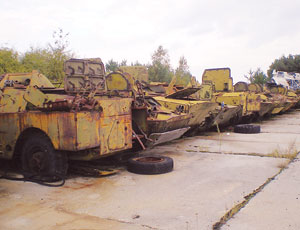More than 250 trucks, troop carriers, excavators and even helicopters lie rusting in a corner of the�Buriakovka low- and intermediate-radioactive solid-waste site in the empty countryside some 25 kilometerss from Chernobyl. Used in the emergency after the accident, the vehicles will lie for de�cades in the field until they, or their rust, cease to radiate harmfully. The fate of the vehicles� drivers is not hard to guess.

Buriakovka was completed in 1987 as a 97-hectare graveyard for the solid debris generated by the accident. It has 30 trenches, each 150 meters long, 58 m wide and 4 m deep. Each holds 23,000 cu m of anything from bricks to boilers.
When full, the trenches are covered with sand and clay, covered with topsoil and planted with grass, leaving 4-m-high mounds. The trenches are vast, and 26 are full. New trenches will be dug in between them to raise the site’s capacity within the perimeter, says manager Yuriy Petrovich Dyachenko.
Lined with clay, sand and gravel, all but one of the trenches have been watertight, says Dyachenko. His team still must determine why a single unused trench leaks rainwater. Nevertheless, sampling from 86 boreholes reveals “not a single sign of contamination,” he says.
Nearby, the next-generation facility has been recently commissioned to take another 30 years of Chernobyl low-to-medium solid and solidified liquid waste and store it for 300 years. Its pair of 360-m-long open cellular concrete boxes are 24 m wide and stand 7.5 m tall. A roof fitted on rails will shelter cells being filled and a drainage system in the yard floor will capture spills.
The site is the final element in a $70-million project, including a retrieval plant at Chernobyl and a processing unit. Due for completion in 2003, the system is now expected to start working next year.


Post a comment to this article
Report Abusive Comment